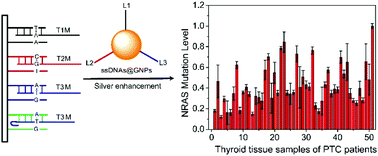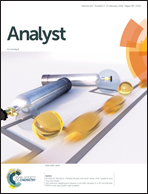DNA microarray-based resonance light scattering assay for multiplexed detection of DNA mutation in papillary thyroid cancer†
Abstract
Highly accurate analysis of single-nucleotide polymorphisms (SNPs) plays an important role in both disease diagnostics and personalized medicine development. In this work, a DNA microarray-based resonance light scattering (RLS) assay has been developed for multiplexed detection of papillary thyroid carcinoma (PTC) related mutation points including BRAFV600E (t1m), NRAS codon 61 (t2m), TERT promoter g.1295228 (t31m) and TERT promoter g.1295250 (t32m) with high sensitivity and selectivity by the attachment of polyvalent ssDNA modified 13 nm gold nanoparticles (ssDNAs@GNPs) followed by silver deposition for signal enhancement. The microarray-based RLS assay provides a detection limit (S/N = 3) at the sub-nanomolar level for the target ssDNAs and determines allele frequencies as low as 0.2% for t1m, 0.2% for t2m, 0.5% for t31m, and 0.5% for t32m in the cocktail of target ssDNAs, respectively. The practicability of the DNA microarray-based RLS assay is demonstrated by profiling of t2m in 50 clinical thyroid tissue samples of PTC patients, and satisfactory results are obtained.



 Please wait while we load your content...
Please wait while we load your content...